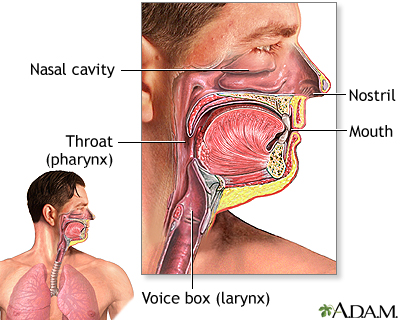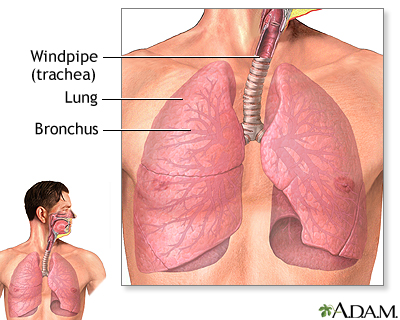Coughing up blood
Hemoptysis; Spitting up blood; Bloody sputum
Coughing up blood is the spitting up of blood or bloody mucus from the lungs and throat (respiratory tract).
Hemoptysis is the medical term for coughing up blood from the respiratory tract.
Images


I Would Like to Learn About:
Considerations
Coughing up blood is not the same as bleeding from the mouth, throat, or gastrointestinal tract.
Blood that comes up with a cough often looks bubbly because it is mixed with air and mucus. It is most often bright red, although it may be rust-colored. Sometimes the mucus contains only streaks of blood.
The outlook depends on what is causing the problem. Most people do well with treatment to treat the symptoms and the underlying disease. People with severe hemoptysis may die.
Causes
A number of conditions, diseases, and medical tests may make you cough up blood. These include:
- Blood clot in the lung
- Breathing food or other material into the lungs (pulmonary aspiration)
- Bronchoscopy with biopsy
- Bronchiectasis
- Bronchitis
- Lung cancer
- Cystic fibrosis
- Inflammation of the blood vessels in the lung (vasculitis)
- Injury to the arteries of the lungs
- Irritation of the throat from violent coughing (small amounts of blood)
- Pneumonia or other lung infections
- Pulmonary edema
- Systemic lupus erythematosus
- Tuberculosis
- Very thin blood (from blood thinning medicines, most often at higher than recommended levels)
Home Care
Medicines that stop coughing (cough suppressants) may help if the problem comes from heavy coughing. These medicines may lead to airway blockages, so check with your health care provider before using them.
Keep track of how long you cough up blood, and how much blood is mixed with the mucus. Call your provider any time you cough up blood, even if you do not have any other symptoms.
When to Contact a Medical Professional
Get medical help right away if you cough up blood and have:
- A cough that produces more than a few teaspoons of blood
- Blood in your urine or stools
- Chest pain
- Dizziness
- Fever
- Lightheadedness
- Severe shortness of breath
What to Expect at Your Office Visit
In an emergency, your provider will give you treatments to control your condition. The provider will then ask you questions about your cough, such as:
- How much blood are you coughing up? Are you coughing up large amounts of blood at a time?
- Do you have blood-streaked mucus (phlegm)?
- How many times have you coughed up blood and how often does it happen?
- How long has the problem been going on? Is it worse at some time such as at night?
- What other symptoms do you have?
The provider will do a complete physical exam and check your chest and lungs. Tests that may be done include:
- Bronchoscopy, a test to view the airways
- Chest CT scan
- Chest x-ray
- Complete blood count
- Lung biopsy
- Lung scan
- Pulmonary arteriography
- Sputum culture and smear
- Test to see if the blood clots normally, such as PT or PTT
References
Brown CA. Hemoptysis. In: Walls RM, ed. Rosen's Emergency Medicine: Concepts and Clinical Practice. 10th ed. Philadelphia, PA: Elsevier; 2023:chap 20.
Swartz MH. The chest. In: Swartz MH, ed. Textbook of Physical Diagnosis: History and Examination. 8th ed. Philadelphia, PA: Elsevier; 2021:chap 13.
BACK TO TOPReview Date: 5/3/2023
Reviewed By: Michael M. Phillips, MD, Emeritus Professor of Medicine, The George Washington University School of Medicine, Washington, DC. Also reviewed by David C. Dugdale, MD, Medical Director, Brenda Conaway, Editorial Director, and the A.D.A.M. Editorial team.

Health Content Provider
06/01/2025
|
A.D.A.M., Inc. is accredited by URAC, for Health Content Provider (www.urac.org). URAC's accreditation program is an independent audit to verify that A.D.A.M. follows rigorous standards of quality and accountability. A.D.A.M. is among the first to achieve this important distinction for online health information and services. Learn more about A.D.A.M.'s editorial policy, editorial process and privacy policy. A.D.A.M. is also a founding member of Hi-Ethics. This site complied with the HONcode standard for trustworthy health information from 1995 to 2022, after which HON (Health On the Net, a not-for-profit organization that promoted transparent and reliable health information online) was discontinued. |
The information provided herein should not be used during any medical emergency or for the diagnosis or treatment of any medical condition. A licensed medical professional should be consulted for diagnosis and treatment of any and all medical conditions. Links to other sites are provided for information only -- they do not constitute endorsements of those other sites. © 1997- 2025 A.D.A.M., a business unit of Ebix, Inc. Any duplication or distribution of the information contained herein is strictly prohibited.
